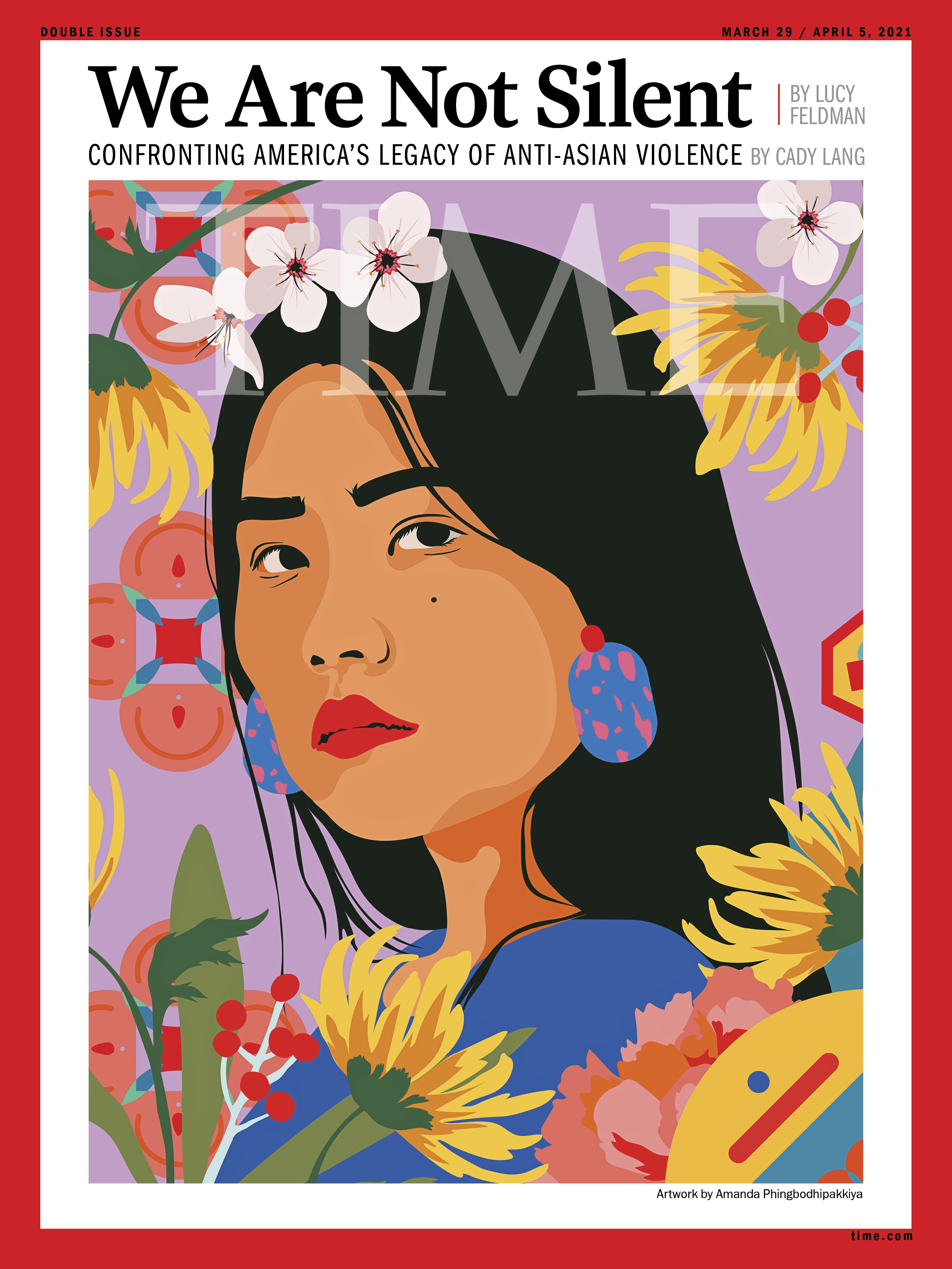
New York-based artist and educator Amanda Phingbodhipakkiya calls the portrait which covers this week’s issue of TIME “With Softness and Power.” The image “reflects the immeasurable strength of Asian American women who are the connective tissue of our communities, yet too often overlooked, fetishized, dehumanized and underestimated.” Phingbodhipakkiya tells TIME. “My hope is to see the beauty of our people reflected in the colors of our communities in a dignified and respectful way.”
The choice of flowers, which feature prominently in the image, was also intentional: “The peony symbolizes solidarity and friendship, the chrysanthemum signifies resilience—it’s one of the few flowers that blooms when it’s cold—and the hawthorn berry represents longevity and protection.”
Calls for solidarity and protection are even more front of mind in the Asian American and Pacific Islander (AAPI) community—alongside an outpouring of grief and anger—in the wake of the Mar. 16 shootings at three spas in the Atlanta, Ga. metropolitan area that left eight dead, including six women of Asian descent. A 21-year-old white man has since been charged with eight counts of murder. The news hit home for Phingbodhipakkiya, an Atlanta native, who spoke to TIME about her work the day after the tragedy.
Read more: ‘We Are Always Waiting Our Turn to Be Important.’ A Love Letter to Asian Americans
“I appreciated that many of [Phingbodhipakkiya’s] artworks featured generations of individuals and sought to depict diversity within the Asian-American population,” adds TIME photo editor Sangsuk Sylvia Kang, who pitched the artist for consideration. “It’s obviously a topic that means a lot to me personally and professionally.”
The cover artwork was an outtake initially created for the NYC Commission on Human Rights’ 2020 public art series “I Still Believe in Our City,” portraits; a version of the image appeared in an art installation that opened last fall in Brooklyn’s Atlantic Avenue-Barclays Center subway station as part of an intergenerational triptych. A number of Phingbodhipakkiya’s other works appeared in subway stations and bus shelters and public places, centering members of the AAPI community in New York City at a time when reports of anti-Asian discrimination and harassment in the city was on a marked rise. Reports increased seven-fold between February-July 2020 and the same time frame in 2019.
It was on the same subway system, just around the time lockdown orders to slow the spread of the COVID-19 virus were put in place in New York that Phingbodhipakkiya, 32, remembers being the victim of racialized abuse. As she sat down to take her seat, a man next to her looked at her, said ‘Ew, gross!’ and ran to the other end of the car.
It was far from the first time she’s been insulted that way, and the ignorant and racist comments haven’t gone away a year later. “The other day, my parents were yelled at in the grocery store to go back to where they came from, and it just hurt so much to hear that from them,” she tells TIME. “I’m worried for their safety.”
Read more: Hate Crimes Against Asian Americans Are on the Rise. Many Say More Policing Isn’t the Answer
Before pursuing a career in art, Phingbodhipakkiya majored in neuroscience in college at Columbia University, and says that training guides her approach to making art — in particular, research on how the human brain processes rejection. “When we are shunned or we feel isolated or alone, our bodies react as if we had experienced physical harm,” she says. “My practice of making the invisible visible—whether it’s microscopic worlds or the often unseen struggles of communities of color—comes from the same place of revealing the unsung or the unseen.”
“This is why I make work that is about belonging, that fosters a sense of belonging, because I love that for all communities of color,” she tells TIME. “It’s so important to see ourselves. It’s a way to say, despite what we have been through as Asian Americans, we’re still here. We don’t scare easily. We’re fighting every day for our shared future.”
More Must-Reads from TIME
- Cybersecurity Experts Are Sounding the Alarm on DOGE
- Meet the 2025 Women of the Year
- The Harsh Truth About Disability Inclusion
- Why Do More Young Adults Have Cancer?
- Colman Domingo Leads With Radical Love
- How to Get Better at Doing Things Alone
- Michelle Zauner Stares Down the Darkness
Write to Olivia B. Waxman at olivia.waxman@time.com